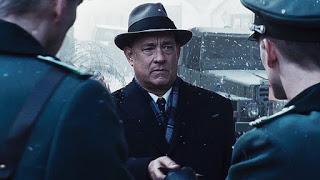 Steven Spielberg's Bridge of Spies (2015) suffers from both distended dramaturgy and a compromised Cold War liberalism not seen since Hubert Humphrey. It wants to celebrate American derringdo against the Soviet Union while simultaneously denouncing American extremism. Thus we're treated an overlong patchwork that stitches a portentous legal drama to a tense spy thriller.
Steven Spielberg's Bridge of Spies (2015) suffers from both distended dramaturgy and a compromised Cold War liberalism not seen since Hubert Humphrey. It wants to celebrate American derringdo against the Soviet Union while simultaneously denouncing American extremism. Thus we're treated an overlong patchwork that stitches a portentous legal drama to a tense spy thriller. In 1957, FBI agents arrest Soviet spy Rudolf Abel (Mark Rylance) in New York. The Justice Department taps insurance attorney Jim Donovan (Tom Hanks) to defend Abel. Donovan grows disgusted with the government railroading Abel, taking his case to the Supreme Court despite adverse media coverage. A few years later, Francis Gary Powers (Austin Stowell) is shot down over Russia, and the CIA hits upon an ingenious solution: send Donovan to negotiate a prisoner exchange. Donovan winds up in East Berlin, finding a new wrinkle: the East German Stasi have arrested an American student, Frederic Pryor (Will Rogers).
Bridge of Spies spends an hour setting its stage. In time-honored Hollywood tradition, noble Donovan holds the line against bloodthirsty reactionaries in a storyline as ponderous as it is predictable. Will Donovan endure derision, death threats and nagging from his wife (Amy Ryan)? You betcha! Frankly, Bridge of Spies' first half seems not only overlong, but pointless except to establish Donovan's liberal bona fides. Apparently, Spielberg isn't comfortable confronting Communism without first attacking American anticommunism.
When Donovan's diplomatic mission starts, Bridge of Spies finally comes to life. Spielberg enlisted the Coen Bros. (along with Matt Charman) to add their mordant humor, and the movie gets mileage out of Abel's drollery, Soviet subterfuge (Abel's fake family) and Donovan's diplomatic bungling. The situation in East Berlin is a mess: the Americans don't care about Pryor, the Soviets don't trust Donovan, the East Germans resent American interference and Soviet heavy-handedness. Officially acting as a "private citizen," Jim disobeys orders to resolve the mess.
Spielberg's direction is impeccable, unflashy except for exquisite period recreations, long takes and occasional handheld shots by Janusz Kaminski. Kaminski effectively contrasts sunny, prosperous America with East Germany's gray gulag state (the Berlin Wall's under construction when Donovan arrives). There are a few set pieces (the Soviets downing Powers' U-2, a failed escape from East Berlin) but more effective scenes simply evoke the period: terrified children watching Duck and Cover, angry press denunciations, Berlin's still-unrepaired ruins.
Tom Hanks naturally makes an unflappable Everyman, a Capra-esque mixture of idealist and cagey negotiator. Mark Rylance is dryly funny and unflappable in the worst circumstances ("Would it help?" he repeats, like a sarcastic Bartleby). Alan Alda and Amy Ryan receive high-billing for negligible roles. Spielberg sprinkles the film with nice character turns: Sebastian Koch's indignant German diplomat, Mikhail Gorevoy's unctuous Soviet spymaster, Dakin Matthews' hectoring Judge.
Bridge of Spies really seems like two movies in one, awkwardly jostling for space. Nothing wrong with Spielberg making a Red Scare drama, but it blends so awkwardly with the spy thriller that it doesn't work.

